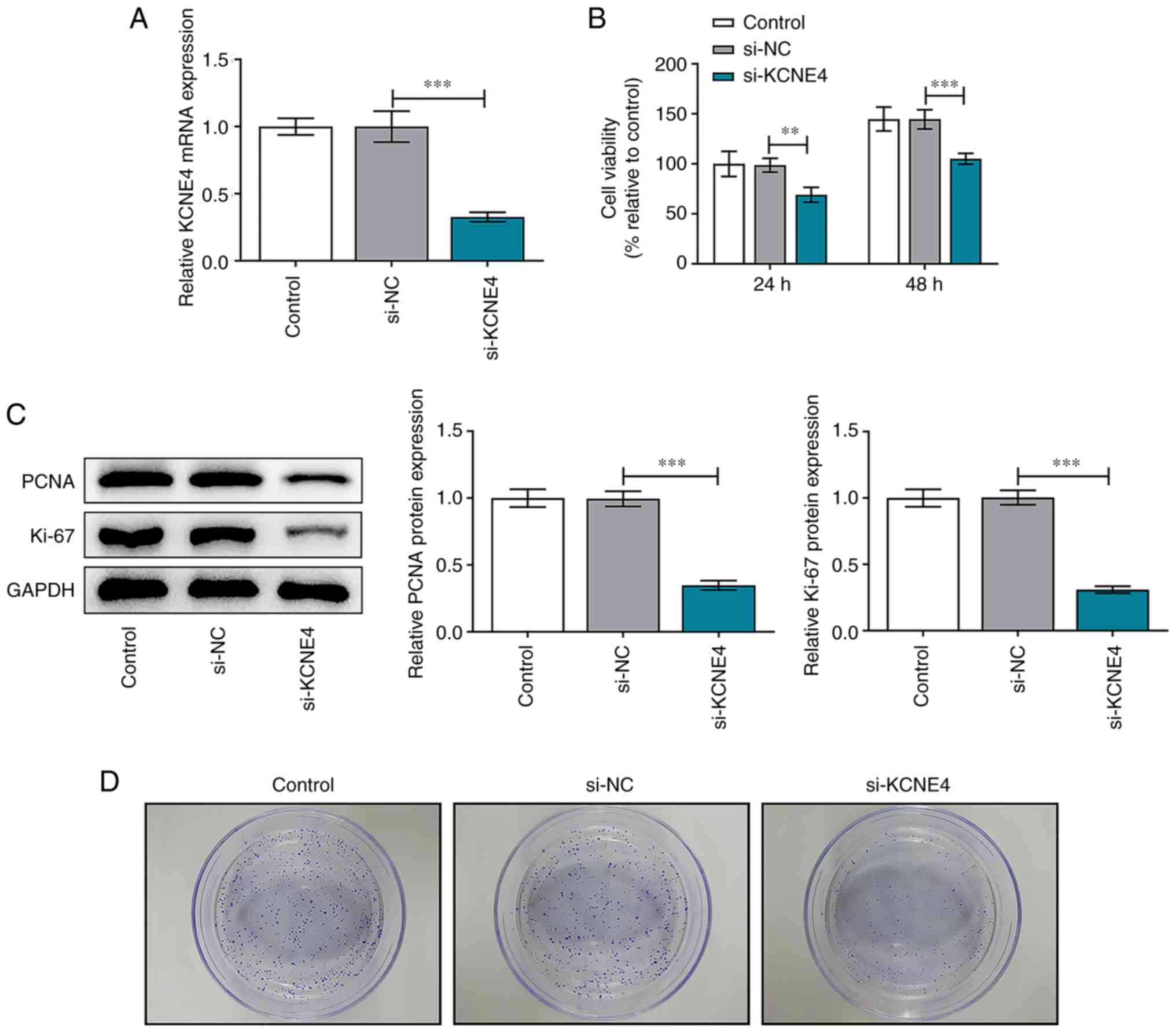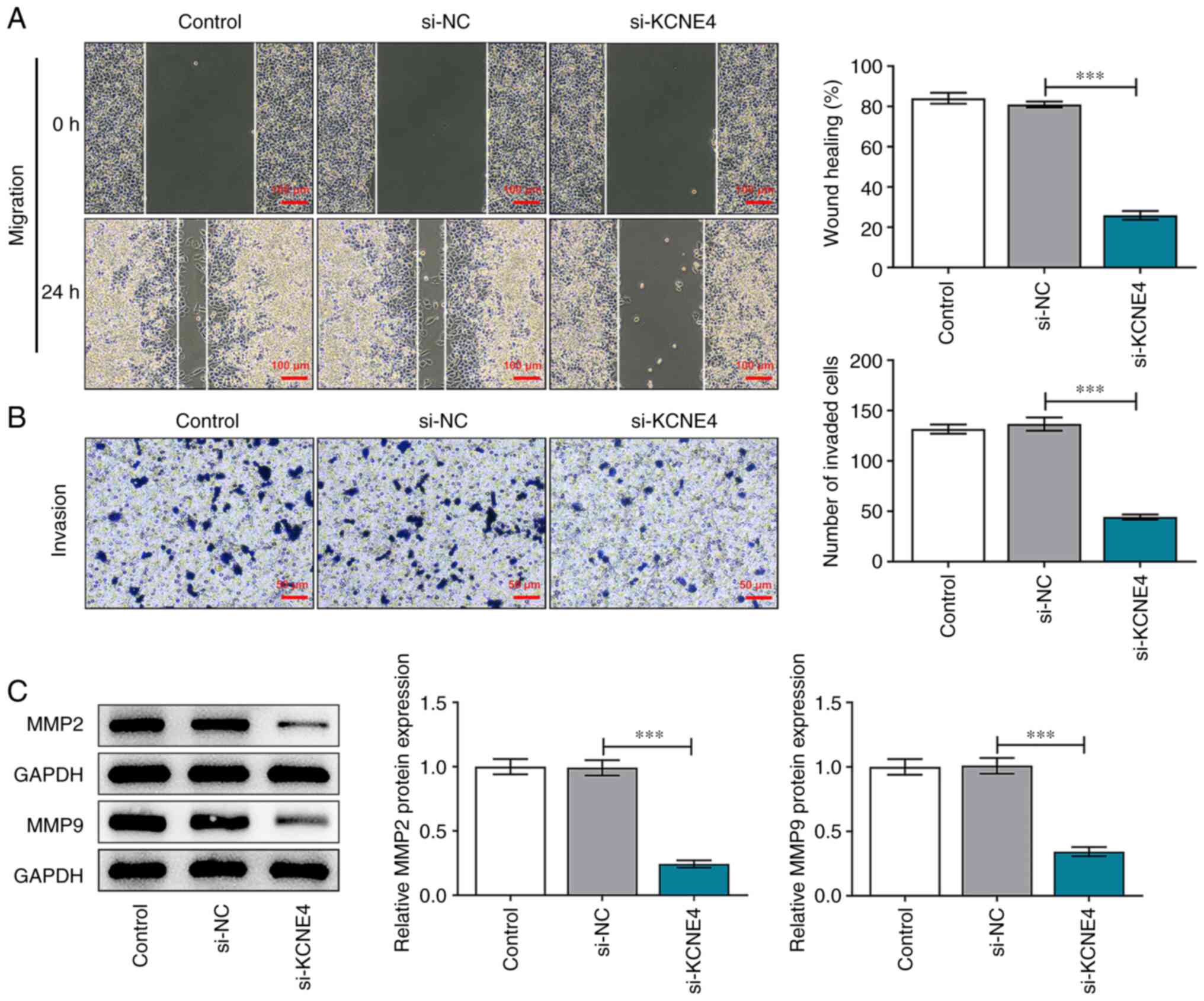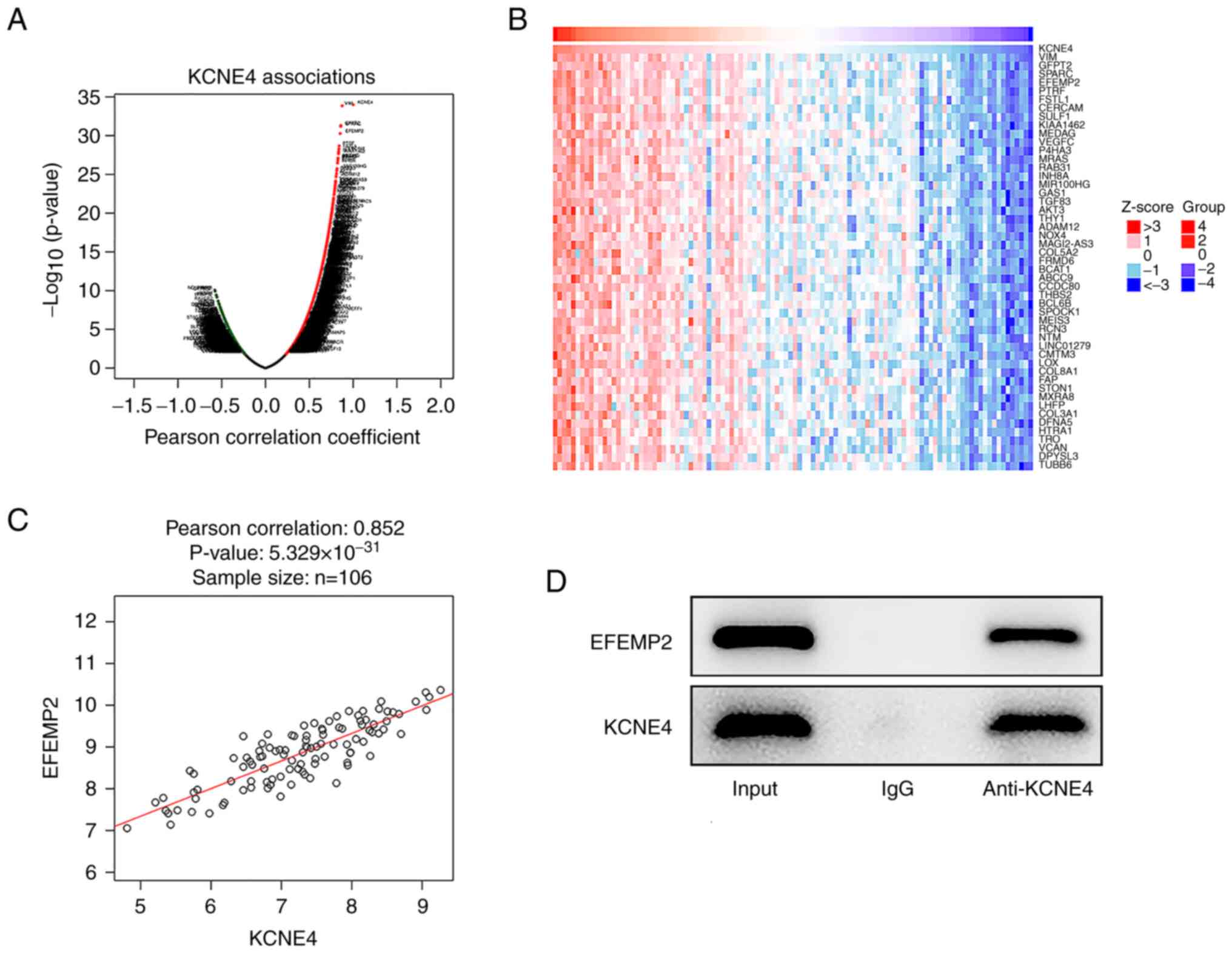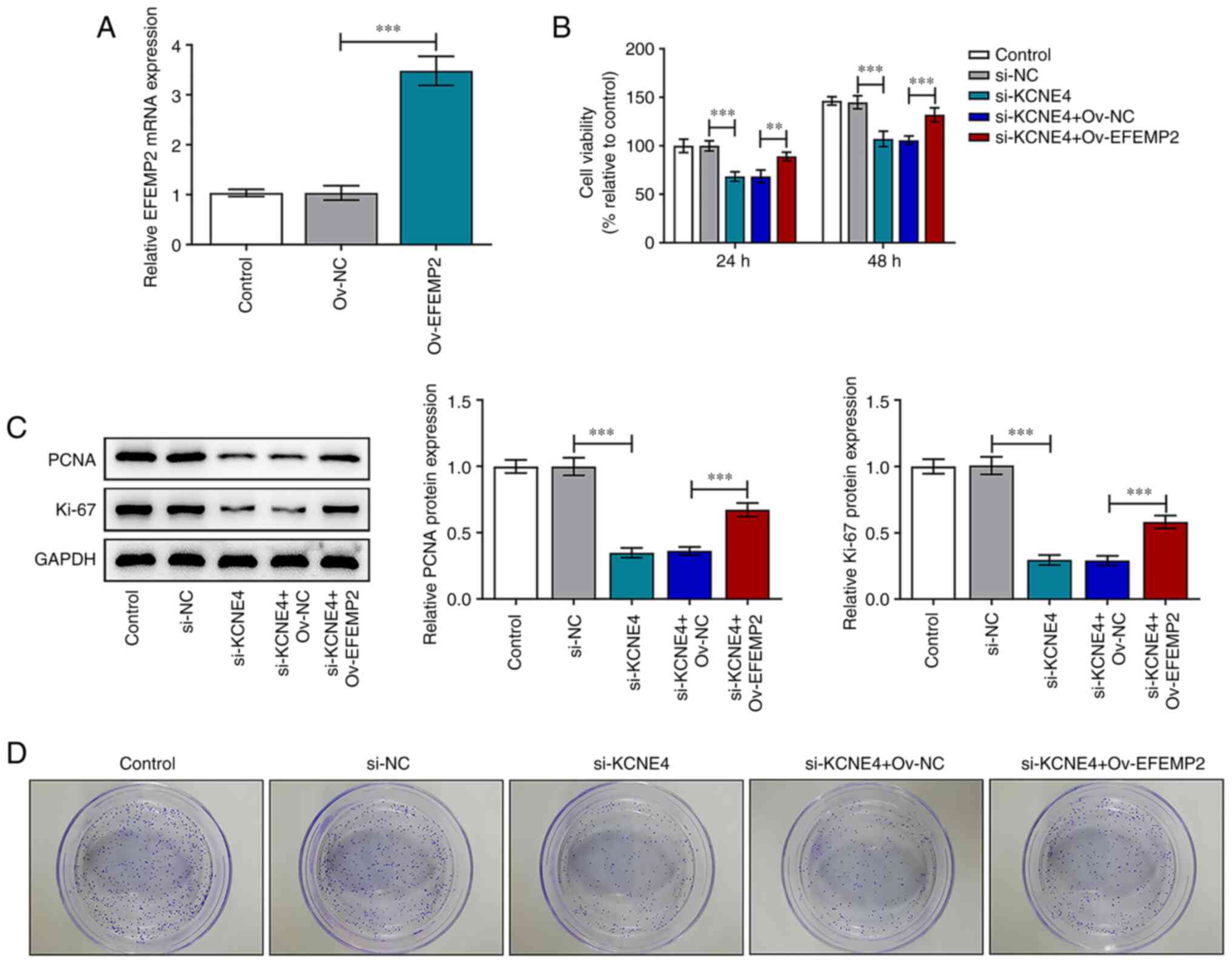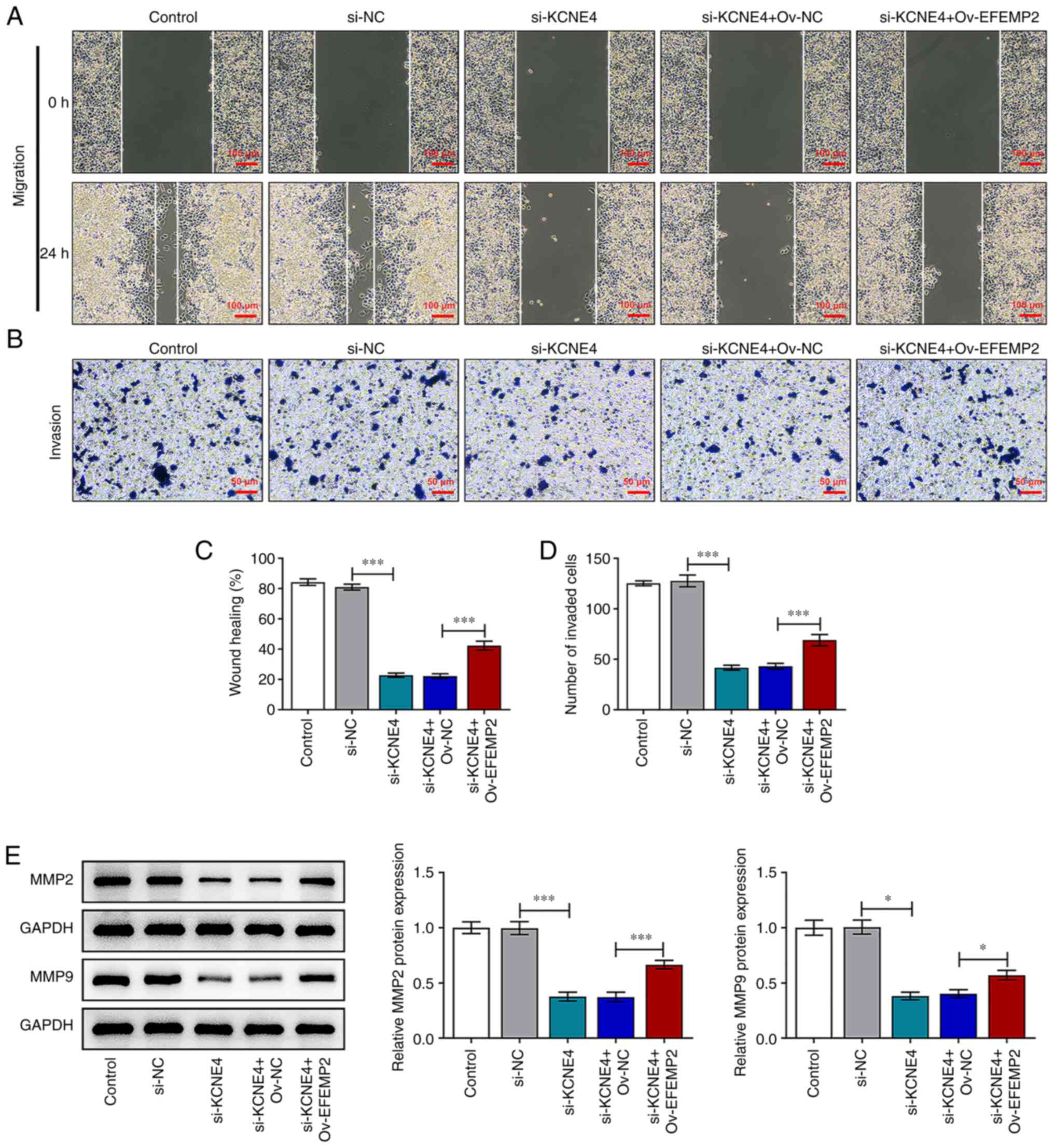Potassium voltage‑gated channel subfamily E member 4 facilitates the malignant progression of colon cancer by enhancing EGF containing fibulin extracellular matrix protein 2 expression
- Authors:
- Published online on: July 3, 2023 https://doi.org/10.3892/etm.2023.12091
- Article Number: 392
-
Copyright: © Xu et al. This is an open access article distributed under the terms of Creative Commons Attribution License.
Abstract
Introduction
Colon cancer has high prevalence worldwide and its rates of morbidity and mortality have maintained an upward trend over the last 5-10 years (1-3). Although early-stage colon cancer generally has a favorable outcome, the majority of patients with colon cancer are diagnosed at a late stage and have a poor prognosis due to local or even distant metastasis (4-6). Therefore, investigation of the molecular mechanism of metastasis is crucial to address an unmet clinical need.
Ion channels are emerging as pivotal modulators of different aspects of cancer cell behavior. The abnormal expression of genes encoding ion-channel proteins, particularly potassium (K+) channel proteins, has attracted considerable attention (7,8). Potassium voltage-gated channel subfamily E (KCNE) proteins are single transmembrane-segment voltage-gated potassium (Kv) channel ancillary subunits that associate with pore-forming subunits to form complexes with unique characteristics (9). The KCNE family comprises five members (KCNE1-5), which can interact with a wide range of channels (10). It has been documented that KCNE4 is highly expressed in multiple types of tumors and participates in tumor vascularization, so as to promote the proliferation, migration and invasion of cancer cells (11,12). Notably, Wu et al (12) revealed that KCNE4 is upregulated in samples from patients with high-risk colorectal cancer (CRC) compared with low-risk CRC, and markedly elevated KCNE4 expression is highly associated with poor progression-free survival in CRC. Furthermore, The University of Alabama at Birmingham Cancer data analysis portal (UALCAN) database shows that KCNE4 is significantly elevated in colon cancer tissues, and KCNE4 expression is positively associated with cancer stage and negatively associated with patient survival in colon cancer.
The genes positively correlated with KCNE4 in colon cancer may be identified based on analysis performed using LinkedOmics database. Moreover, this database shows a strongly positive correlation between KCNE4 and EGF containing fibulin extracellular matrix protein 2 (EFEMP2) using Pearson's correlation analysis. EFEMP2 is a member of the fibulin family of glycoproteins (13). It is involved in the maintenance of cell morphology, as well as the growth, adhesion and movement of cells, and is closely associated with the development of various types of tumors (14,15). It has been reported that EFEMP2 is highly expressed in colon cancer cells and may promote colon cancer cell invasion and growth through the ERK1/2 signaling pathway (16). Additionally, EFEMP2 expression is also upregulated in the tumor tissues of patients with CRC, even at an early stage (17).
Therefore, the current study aimed to elucidate the functional role of KCNE4 in the biological behaviors of colon cancer cells and to investigate the molecular mechanism underlying the involvement of KCNE4 and its highly correlated gene EFEMP2 in the malignant progression of colon cancer.
Materials and methods
UALCAN analysis
KCNE4 expression in colon cancer tissues was compared with that in normal tissues using the UALCAN database (http://ualcan.path.uab.edu), and the associations between KCNE4 expression and the pathological stages of colon cancer and the survival probability of patients with colon cancer were also investigated.
LinkedOmics analysis
The LinkedOmics database (http://www.linkedomics.org/) is a web-based platform for the analysis of 32 The Cancer Genome Atlas cancer-associated multi-dimensional datasets. The KCNE4-associated genes were analyzed using Pearson's correlation coefficient and presented in a volcano plot, heat map and scatter plot.
Cell culture
The human colon cancer cell lines HCT-116 (cat. no. TCHu 99), SW480 (cat. no. TCHu172), SW1116 (cat. no. TCHu174), Caco2 (cat. no. TCHu146) and LoVo (cat. no. TCHu 82) were purchased from The Cell Bank of Type Culture Collection of The Chinese Academy of Sciences. The NCM460 normal colonic mucosa cell line (cat. no. CP-H040) was purchased from Procell Life Science & Technology Co., Ltd. All cells were cultured in Dulbecco's modified Eagle's medium (HyClone; Cytiva) supplemented with 10% fetal bovine serum (FBS; Hyclone; Cytiva), 100 U/ml penicillin and 100 µg/ml streptomycin in a humidified atmosphere with 5% CO2 at 37˚C.
Cell transfection
Small interfering RNA (siRNA) targeting KCNE4 (si-KCNE4; 5'-GATTGGCTGTAAGTATCTCTA-3') and scrambled negative control (si-NC, 5'-GGATCACTAGTTACGATTGTT-3') were obtained from Shanghai GenePharma Co., Ltd. The EFEMP2 overexpression plasmid (Ov-EFEMP2) was established by inserting the EFEMP2 gene into a pcDNA3.1 vector (Shanghai GenePharma Co., Ltd.), whereas an empty vector served as the NC (Ov-NC). Transfection with si-KCNE4 (50 nM), si-NC (50 nM), Ov-EFEMP2 (0.5 µg) or Ov-NC (0.5 µg) was performed using Lipofectamine® 2000 (Invitrogen; Thermo Fisher Scientific, Inc.) at 37˚C for 4 h strictly according to the manufacturer's guidelines. After another 48 h of incubation at 37˚C, the cells were collected for subsequent experiments.
Cell Counting Kit-8 (CCK-8) assay
The viability of HCT-116 cells was determined using a CCK-8 assay. Cells (5,000 cells/well) grown in 96-well plates were cultured for 48 h. Afterwards, 10 µl CCK-8 solution (Beyotime Institute of Biotechnology) was added to each well and incubated at 37˚C for 2 h. The optical density at 450 nm was detected using a microplate-reader (Bio-Rad Laboratories, Inc.).
Colony formation assay
The colony-forming ability of HCT-116 cells was determined via colony formation assay. Cells plated at a density of 500 cells/well in 6-well plates were maintained in complete medium for 10 days. After that, the cells were fixed with 4% paraformaldehyde at room temperature for 15 min and stained with 0.1% crystal violet solution (Beijing Solarbio Science & Technology Co., Ltd.) at room temperature for 10 min. Visible colonies were photographed under a light microscope (Olympus Corporation) and were counted using ImageJ software (Version 1.46; National Institutes of Health). Colonies consisted of ≥50 cells.
Wound healing assay
The migratory ability of HCT-116 cells was assessed using a wound healing assay. Cells (1x105 cells/well) were seeded into 6-well plates and cultured up to 90% confluence. Then, the cells were scratched with a sterile 200-µl pipette tip and the detached cells were washed away with PBS. Afterwards, the cells were incubated in serum-free medium at 37˚C for 24 h and the area of the wound was photographed at 0 and 24 h under a microscope (magnification, x100). Migration was assessed as follows: Migration (%)=[(0 h average scratch distance-24 h average scratch distance)/0 h average scratch distance] x100.
Transwell assay
The invasive ability of HCT-116 cells was assessed by performing a Transwell assay. The cells were re-suspended in serum-free medium and seeded at a density of 2x104 cells/well into the upper compartment of a Transwell chamber (Corning, Inc.), which was precoated with 50 µl Matrigel (Beijing Solarbio Science & Technology Co., Ltd.) at 37˚C for 30 min. The lower chambers were filled with 600 µl FBS-containing medium. After 24 h of incubation at 37˚C, the invaded cells were fixed with 4% paraformaldehyde and stained with 0.1% crystal violet solution at room temperature for 20 min. Finally, the invaded cells were photographed and counted under a light microscope (magnification, x200).
Reverse transcription-quantitative PCR (RT-qPCR)
Total RNA was isolated from cells using TRIzol® reagent (Invitrogen; Thermo Fisher Scientific, Inc.). Subsequently, the RNA was reverse transcribed into cDNA using a PrimeScript RT Kit (Takara Bio, Inc.). The RT conditions were performed at 30˚C as the priming stage for 10 min, 42˚C as the RT step for 30 min and 95˚C as the RT inactivation stage for 5 min. Then, qPCR reactions were performed on an ABI PRISM 7900 Real-Time PCR system (Thermo Fisher Scientific, Inc.) using SYBR Premix Ex Taq kit (Takara Bio, Inc.). The thermocycling conditions were as follows: 95˚C for 10 min, followed by 35 cycles of 95˚C for 15 sec and 65˚C for 60 sec. The sequences of the primers were as follows: KCNE4 forward: 5'-CACCGCTACCTGAAAACCCT-3' and reverse: 5'-TTGATCGTGGCAGAGTGAGC-3'; EFEMP2 forward: 5'-GAGTGTCTGACCATCCCTGAG-3' and reverse: 5'-GCCGTGTAGGTCGTTGATGAC-3'; GAPDH forward: 5'-CAGGAGGCATTGCTGATGAT-3' and reverse: 5'-GAAGGCTGGGGCTCATTT-3'. GAPDH served as the internal control. Relative gene expression levels of KCNE4 and EFEMP2 were normalized to GAPDH and calculated via the 2-ΔΔCq method (18).
Western blotting analysis
Total protein was isolated from cells using RIPA lysis buffer (Beyotime Institute of Biotechnology) and protein concentrations were quantified using a BCA protein assay kit (Beyotime Institute of Biotechnology). Equal amounts of protein samples (30 µg/lane) were subjected to 10% sodium dodecyl sulfate (SDS)-polyacrylamide gel electrophoresis and then transferred onto polyvinylidene fluoride membranes (MilliporeSigma). After blocking in 5% skimmed milk for 1 h at room temperature, the membranes were incubated with specific antibodies against KCNE4 (ab254642; 1:1,000), proliferating cell nuclear antigen (PCNA; ab92552; 1:1,000), Ki-67 (ab92742; 1:5,000), MMP2 (ab181286; 1:1,000), MMP9 (ab137867; 1:1,000), EFEMP2 (ab125073; 1:1,000) and GAPDH (ab181602; 1:10,000), all from Abcam, overnight at 4˚C. The next day, the membranes were incubated with goat anti-rabbit horseradish peroxidase-conjugated IgG secondary antibody (ab205718; 1:50,000; Abcam) for 1.5 h at room temperature. GAPDH served as the internal control. Signals of the immunoblots were developed using a BeyoECL plus kit (Beyotime Institute of Biotechnology) and analyzed with ImageJ software v1.8.0 (National Institutes of Health).
Co-immunoprecipitation (Co-IP)
The interaction between KCNE4 and EFEMP2 was verified via Co-IP. Cells were lysed using IP lysis buffer (Beyotime Institute of Biotechnology). The supernatant was collected after centrifugation at 13,000 x g for 10 min at 4˚C. Next, anti-KCNE4 (ab254642; 1:200; Abcam) or anti-IgG (ab205718; 1:1,000; Abcam) was added to 250 µl cell lysate and incubated overnight at 4˚C. On the following day, the cell lysates were cultured with 25 µl protein A/G agarose beads (Santa Cruz Biotechnology, Inc.) for 4 h at 4˚C to bind the antibody complexes. Following centrifugation at 1,000 x g for 2 min at 4˚C, the agarose beads were washed in lysis buffer 3-4 times. Finally, a total of 15 µl 2X SDS sample buffer was added and the samples were boiled at 100˚C for 5 min, followed by western blot analysis to detect EFEMP2 and KCNE4, as aforementioned.
Statistical analysis
Data from three independent experiments are displayed as the mean ± standard deviation (SD). One-way analysis of variance followed by Tukey's post hoc test was employed for analyzing the statistical significance of differences among multiple groups. P<0.05 was considered to indicate a statistically significant difference.
Results
KCNE4 is highly expressed in colon cancer
KCNE4 expression in colon cancer tissues and normal tissues, as well as the relationships of KCNE4 expression with the pathological stage of colon cancer and the survival probability of patients with colon cancer were explored using the UALCAN database. The UALCAN data indicated that KCNE4 was upregulated in colon cancer tissues compared with normal tissues (Fig. 1A). In addition, the expression level of KCNE4 in colon cancer tissues was positively associated with the cancer stage; KCNE4 expression in late-stage colon cancer was higher than that in early-stage colon cancer (Fig. 1B). Furthermore, patients with colon cancer whose tissues had high KCNE4 expression had a shorter duration of survival than those with low KCNE4 expression (Fig. 1C). In the present study, differences in the expression levels of KCNE4 in the HCT-116, SW480, SW1116, Caco2 and LoVo human colon cancer cell lines and the NCM460 normal colonic mucosa cell line were assessed via RT-qPCR and western blot assays. The KCNE4 mRNA (Fig. 1D) and protein (Fig. 1E) expression levels in the colon cancer cells were markedly increased compared with those in NCM460 cells, and the expression levels in HCT-116 cells were particularly high. Therefore, HCT-116 cells were selected for subsequent experiments.
KCNE4 knockdown suppresses the proliferative and colony-forming abilities of colon cancer cells
HCT-116 cells were transfected with si-KCNE4 or si-NC and transfection efficiency was validated via RT-qPCR. Transfection with si-KCNE4 significantly downregulated KCNE4 expression compared with transfection with si-NC (Fig. 2A). CCK-8 assay results indicated that KCNE4 knockdown significantly reduced the viability of HCT-116 cells (Fig. 2B). Furthermore, reduced expression levels of PCNA and Ki-67 in the HCT-116 cells transfected with si-KCNE4 were observed, which also suggested that the viability of the colon cancer cells was repressed by the downregulation of KCNE4 (Fig. 2C). In addition, the colony formation assay revealed that the downregulation of KCNE4 suppressed the colony formation ability of the HCT-116 cells (Fig. 2D).
KCNE4 knockdown weakens the migratory and invasive capacities of colon cancer cells
Wound healing and Transwell assays demonstrated that the migratory and invasive abilities of HCT-116 cells were significantly suppressed by KCNE4 knockdown (Fig. 3A and B). MMP2 and MMP9 are gelatinases that are able to degrade and remodel the extracellular matrix (19). Therefore, MMP2 and MMP9 play important roles in promoting the metastasis of cells. Decreased expression levels of MMP2 and MMP9 in the HCT-116 cells transfected with si-KCNE4 compared with those transfected with si-NC also indicated that the downregulation of KCNE4 restrained the migration and invasion of the colon cancer cells (Fig. 3C).
Positive correlation between KCNE4 and EFEMP2
Genes associated with the key gene KCNE4 were identified using the LinkedOmics database. The genes indicated to be highly associated with KCNE4 in colon cancer are displayed in a volcano plot (Fig. 4A). The top 50 genes significantly positively correlated with KCNE4 in colon cancer are shown in a heat map (Fig. 4B). Using Pearson's correlation analysis, it was revealed that KCNE4 exhibited a strongly positive correlation with EFEMP2 (Fig. 4C). Moreover, the interaction between KCNE4 and EFEMP2 was validated via Co-IP analysis. EFEMP2 protein was detected in the anti-KCNE4 group, indicating that KCNE4 interacted with and bound to EFEMP2 (Fig. 4D).
EFEMP2 is highly expressed in colon cancer
Expression differences of EFEMP2 in the HCT-116 and SW1116 human colon cancer cell lines and the NCM460 normal colonic mucosa cell line were assessed via RT-qPCR and western blot assay. In comparison with those in NCM460 cells, EFEMP2 mRNA (Fig. 5A) and protein (Fig. 5B) expression levels in both colon cancer cell lines were significantly upregulated.
KCNE4 knockdown suppresses the proliferative and colony formation abilities of colon cancer cells by downregulating EFEMP2
Rescue experiments were carried out to explore whether KCNE4 mediates colon cancer progression via the regulation of EFEMP2 expression. The transfection efficiency of Ov-EFEMP2 was validated via RT-qPCR, and this vector markedly upregulated EFEMP2 expression (Fig. 6A). The downregulation of KCNE4 reduced the viability of the HCT-116 cells, and this reduction was attenuated by EFEMP2 overexpression (Fig. 6B). Increased PCNA and Ki-67 expression levels in the HCT-116 cells co-transfected with si-KCNE4 and Ov-EFEMP2 compared with those transfected with si-KCNE4 and Ov-NC also indicated that the upregulation of EFEMP2 abolished the suppressive effects of KCNE4 knockdown on the viability of colon cancer cells (Fig. 6C). In addition, the decreased colony formation of HCT-116 cells transfected with si-KCNE4 was attenuated by EFEMP2 overexpression (Fig. 6D). In summary, these results indicate that KCNE4 knockdown suppressed the proliferative and colony formation abilities of colon cancer cells via the downregulation of EFEMP2 expression.
KCNE4 knockdown weakens the migratory and invasive capacities of colon cancer cells by downregulating EFEMP2
The downregulation of KCNE4 repressed the migratory and invasive abilities of colon cancer cells, and these changes were reversed by EFEMP2 overexpression (Fig. 7A-D). Furthermore, increased MMP2 and MMP9 expression levels in the HCT-116 cells transfected with si-KCNE4 and Ov-EFEMP2 compared with those transfected with si-KCNE4 and Ov-NC also indicated that upregulation of EFEMP2 abolished the suppressive effects of KCNE4 knockdown on the migration and invasion of colon cancer cells (Fig. 7E). In conclusion, these results suggest that KCNE4 knockdown weakens the migratory and invasive capacities of colon cancer cells via the downregulation of EFEMP2 expression.
Discussion
Colon cancer is a malignant tumor of the gastrointestinal tract, which mostly occurs in the rectum and colon (1,2). Tumor metastasis results in the poor outcome of patients in the advanced stages of colon cancer (4). Although several biomarkers associated with the development of colon cancer have been documented, further animal experiments and even long-term clinical trials are required for the application of conventional biomarkers in the diagnosis and treatment of colon cancer. Therefore, it is urgently important to develop more effective biomarkers that are highly associated with colon cancer metastasis, to expand the screening range of clinical gene therapy for colon cancer.
Ion channels allow the passage of ions from one side of the membrane to the other (20). Ion channels play critical roles in the generation and facilitation of the transmission of information within various tissues and cells (21). There is evidence to suggest that the abnormal modulation of ion channels and ancillary proteins could lead to serious diseases, including multiple cancers (22,23). Pivotal roles have been indicated for a variety of ion channels, including KCNE, in the development of several tumors. KCNE4 is the largest of the KCNE subunits and can regulate a variety of Kv channels (24). Furthermore, Wu et al (12) reported that the high expression of KCNE4 in CRC predicts a poor prognosis. In the current research, it was demonstrated that KCNE4 was highly expressed in colon cancer cells, and the knockdown of KCNE4 suppressed the proliferative, colony-forming, migratory and invasive capacities of colon cancer cells.
The positive correlation of the gene EFEMP2 with KCNE4 in colon cancer was identified using the LinkedOmics database. In a previous study, Zuo et al (25) discovered that EFEMP2 enhanced the invasive ability of breast cancer cells. In addition, Wang et al (26) confirmed that EFEMP2 expression is elevated in gliomas, and the silencing of EFEMP2 inhibits glioma cell proliferation and invasion. Furthermore, Yuen et al (27) reported that EFEMP2 is closely associated with colon cancer progression. Importantly, EFEMP2 has been exposed to function as a modulator in the biological behaviors of colon cancer cells (16). In the present study, the Co-IP assay verified that KCNE4 interacted with and bound to EFEMP2, and the suppressive effects of KCNE4 knockdown on the proliferative, colony-forming, migratory and invasive abilities of colon cancer cells were abolished by EFEMP2 overexpression.
In conclusion, the downregulation of KCNE4 inhibited the proliferation, colony formation, migration and invasion of colon cancer cells via the suppression of EFEMP2 expression. These results indicated that KCNE4 and EFEMP2 serve as oncogenes, contributing to the malignant progression of colon cancer. These findings are beneficial to the development of a promising approach for the treatment of colon cancer. However, in vivo analysis should be conducted to support the findings of this study. In addition, the in-depth mechanism underlying the effects of KCNE4/EFEMP2 in tumor promotion requires further investigation to elucidate the predictive values of KCNE4/EFEMP2 in the treatment of colon cancer.
Acknowledgements
Not applicable.
Funding
Funding: No funding was received.
Availability of data and materials
The datasets used and/or analyzed during the current study are available from the corresponding author on reasonable request.
Authors' contributions
YX, DW and GZ searched the literature, designed the study and performed the experiments. YX and DW collected the data, interpreted the results and wrote the manuscript. GZ critically revised the manuscript. YX and GZ confirm the authenticity of all the raw data. All authors read and approved the final manuscript.
Ethics approval and consent to participate
Not applicable.
Patient consent for publication
Not applicable.
Competing interests
The authors declare that they have no competing interests.
References
|
Martin MJ: Current stage-specific chemotherapeutic options in colon cancer. Expert Rev Anticancer Ther. 5:695–704. 2005.PubMed/NCBI View Article : Google Scholar | |
|
Utomo B, Alvarez C and Baldonedo RF: Management of colorectal cancer patients undergoing a colonic stenting: A multidisciplinary team approach. Gastroenterol Nurs. 40:342–349. 2017.PubMed/NCBI View Article : Google Scholar | |
|
Sung H, Ferlay J, Siegel RL, Laversanne M, Soerjomataram I, Jemal A and Bray F: Global cancer statistics 2020: GLOBOCAN estimates of incidence and mortality worldwide for 36 cancers in 185 countries. CA Cancer J Clin. 71:209–249. 2021.PubMed/NCBI View Article : Google Scholar | |
|
Willaert W, Mareel M, Van De Putte D, Van Nieuwenhove Y, Pattyn P and Ceelen W: Lymphatic spread, nodal count and the extent of lymphadenectomy in cancer of the colon. Cancer Treat Rev. 40:405–413. 2014.PubMed/NCBI View Article : Google Scholar | |
|
Zhang Z, Jia H, Wang Y, Du B and Zhong J: Association of MACC1 expression with lymphatic metastasis in colorectal cancer: A nested case-control study. PLoS One. 16(e0255489)2021.PubMed/NCBI View Article : Google Scholar | |
|
Ye X, Brabletz T, Kang Y, Longmore GD, Nieto MA, Stanger BZ, Yang J and Weinberg RA: Upholding a role for EMT in breast cancer metastasis. Nature. 547:E1–E3. 2017.PubMed/NCBI View Article : Google Scholar | |
|
Iorio J, Duranti C, Lottini T, Lastraioli E, Bagni G, Becchetti A and Arcangeli A: KV11.1 potassium channel and the Na+/H+ antiporter NHE1 K pH in colorectal cancer cells. Front Pharmacol. 11(848)2020.PubMed/NCBI View Article : Google Scholar | |
|
Hou X, Tang L, Li X, Xiong F, Mo Y, Jiang X, Deng X, Peng M, Wu P, Zhao M, et al: Potassium channel protein KCNK6 promotes breast cancer cell proliferation, invasion, and migration. Front Cell Dev Biol. 9(616784)2021.PubMed/NCBI View Article : Google Scholar | |
|
Abbott GW: KCNE4 and KCNE5: K(+) channel regulation and cardiac arrhythmogenesis. Gene. 593:249–260. 2016.PubMed/NCBI View Article : Google Scholar | |
|
Yu H, Lin Z, Mattmann ME, Zou B, Terrenoire C, Zhang H, Wu M, McManus OB, Kass RS, Lindsley CW, et al: Dynamic subunit stoichiometry confers a progressive continuum of pharmacological sensitivity by KCNQ potassium channels. Proc Natl Acad Sci USA. 110:8732–8737. 2013.PubMed/NCBI View Article : Google Scholar | |
|
Biasiotta A, D'Arcangelo D, Passarelli F, Nicodemi EM and Facchiano A: Ion channels expression and function are strongly modified in solid tumors and vascular malformations. J Transl Med. 14(285)2016.PubMed/NCBI View Article : Google Scholar | |
|
Wu B, Tao L, Yang D, Li W, Xu H and He Q: Development of an immune infiltration-related eight-gene prognostic signature in colorectal cancer microenvironment. Biomed Res Int. 2020(2719739)2020.PubMed/NCBI View Article : Google Scholar | |
|
Song L, Li XX, Liu XY, Wang Z, Yu Y, Shi M, Jiang B and He XP: EFEMP2 suppresses the invasion of lung cancer cells by inhibiting epithelial-mesenchymal transition (EMT) and down-regulating MMPs. Onco Targets Ther. 13:1375–1396. 2020.PubMed/NCBI View Article : Google Scholar | |
|
Zhang D, Wang S, Chen J, Liu H, Lu J, Jiang H, Huang A and Chen Y: Fibulin-4 promotes osteosarcoma invasion and metastasis by inducing epithelial to mesenchymal transition via the PI3K/Akt/mTOR pathway. Int J Oncol. 50:1513–1530. 2017.PubMed/NCBI View Article : Google Scholar | |
|
Chen J, Liu Z, Fang S, Fang R, Liu X, Zhao Y, Li X, Huang L and Zhang J: Fibulin-4 is associated with tumor progression and a poor prognosis in ovarian carcinomas. BMC Cancer. 15(91)2015.PubMed/NCBI View Article : Google Scholar | |
|
Zhao J, Xu J, Zhao J and Zhang R: EFEMP2 promotes colon cancer cell invasion and growth through the ERK1/2 signaling pathway. Int J Clin Exp Pathol. 12:851–856. 2019.PubMed/NCBI | |
|
Yao L, Lao W, Zhang Y, Tang X, Hu X, He C, Hu X and Xu LX: Identification of EFEMP2 as a serum biomarker for the early detection of colorectal cancer with lectin affinity capture assisted secretome analysis of cultured fresh tissues. J Proteome Res. 11:3281–3294. 2012.PubMed/NCBI View Article : Google Scholar | |
|
Livak KJ and Schmittgen TD: Analysis of relative gene expression data using real-time quantitative PCR and the 2(-Delta Delta C(T)) method. Methods. 25:402–408. 2001.PubMed/NCBI View Article : Google Scholar | |
|
Phillips PA, McCarroll JA, Park S, Wu MJ, Pirola R, Korsten M, Wilson JS and Apte MV: Rat pancreatic stellate cells secrete matrix metalloproteinases: implications for extracellular matrix turnover. Gut. 52:275–282. 2003.PubMed/NCBI View Article : Google Scholar | |
|
Siwy Z, Heins E, Harrell CC, Kohli P and Martin CR: Conical-nanotube ion-current rectifiers: the role of surface charge. J Am Chem Soc. 126:10850–10851. 2004.PubMed/NCBI View Article : Google Scholar | |
|
Shepherd VA, Beilby MJ and Shimmen T: Mechanosensory ion channels in charophyte cells: the response to touch and salinity stress. Eur Biophys J. 31:341–355. 2002.PubMed/NCBI View Article : Google Scholar | |
|
Van den Eynde C, De Clercq K and Vriens J: Transient receptor potential channels in the epithelial-to-mesenchymal transition. Int J Mol Sci. 22(8188)2021.PubMed/NCBI View Article : Google Scholar | |
|
Kärki T and Tojkander S: TRPV Protein family-from mechanosensing to cancer invasion. Biomolecules. 11(1019)2021.PubMed/NCBI View Article : Google Scholar | |
|
Hu Z, Wei W, Zhou L, Chen M and Abbott GW: Kcne4 deletion sex-specifically predisposes to cardiac arrhythmia via testosterone-dependent impairment of RISK/SAFE pathway induction in aged mice. Sci Rep. 8(8258)2018.PubMed/NCBI View Article : Google Scholar | |
|
Zuo T, Shan J, Liu Y, Xie R, Yu X and Wu C: EFEMP2 mediates GALNT14-dependent breast cancer cell invasion. Transl Oncol. 11:346–352. 2018.PubMed/NCBI View Article : Google Scholar | |
|
Wang L, Chen Q, Chen Z, Tian D, Xu H, Cai Q, Liu B and Deng G: EFEMP2 is upregulated in gliomas and promotes glioma cell proliferation and invasion. Int J Clin Exp Pathol. 8:10385–10393. 2015.PubMed/NCBI | |
|
Yuen HF, McCrudden CM, Huang YH, Tham JM, Zhang X, Zeng Q, Zhang SD and Hong W: TAZ expression as a prognostic indicator in colorectal cancer. PLoS One. 8(e54211)2013.PubMed/NCBI View Article : Google Scholar |




